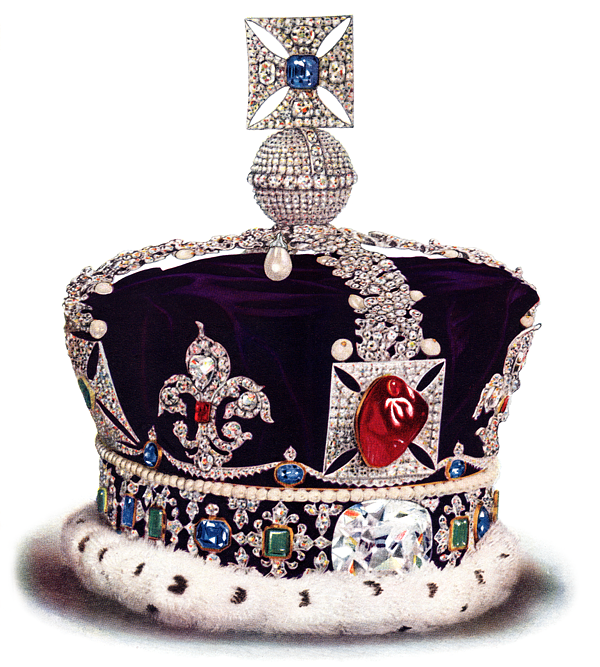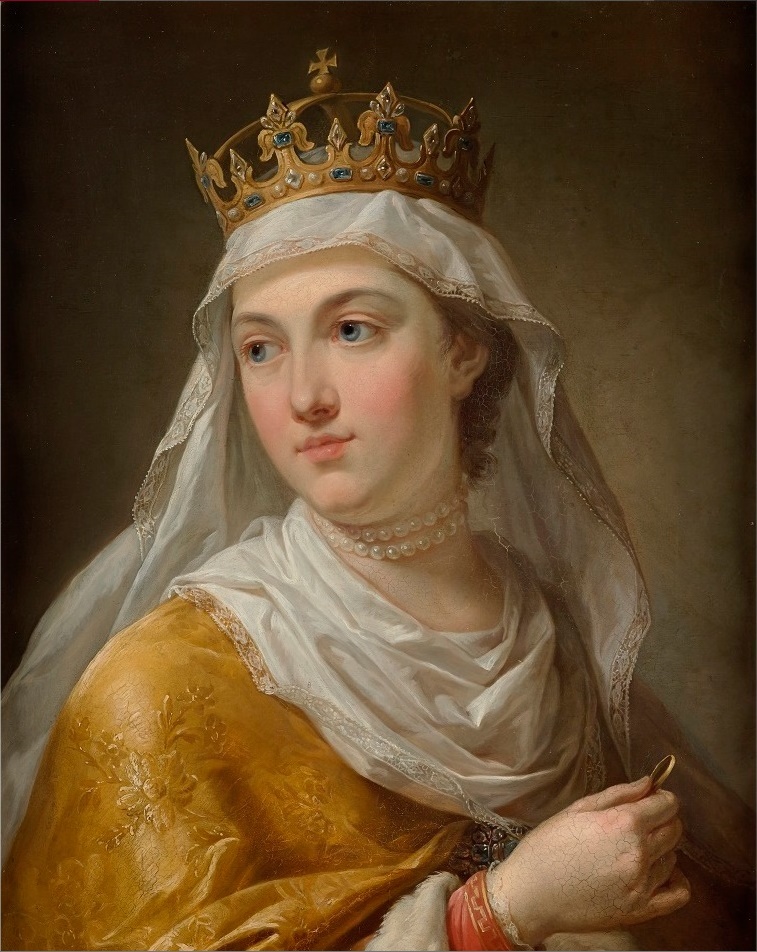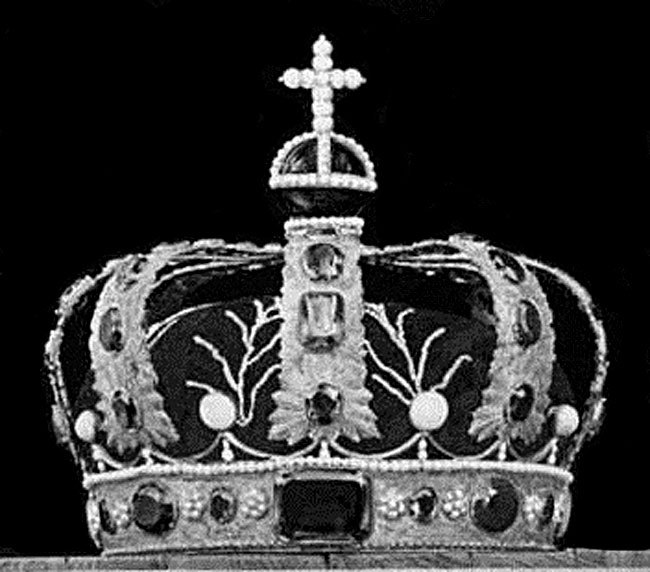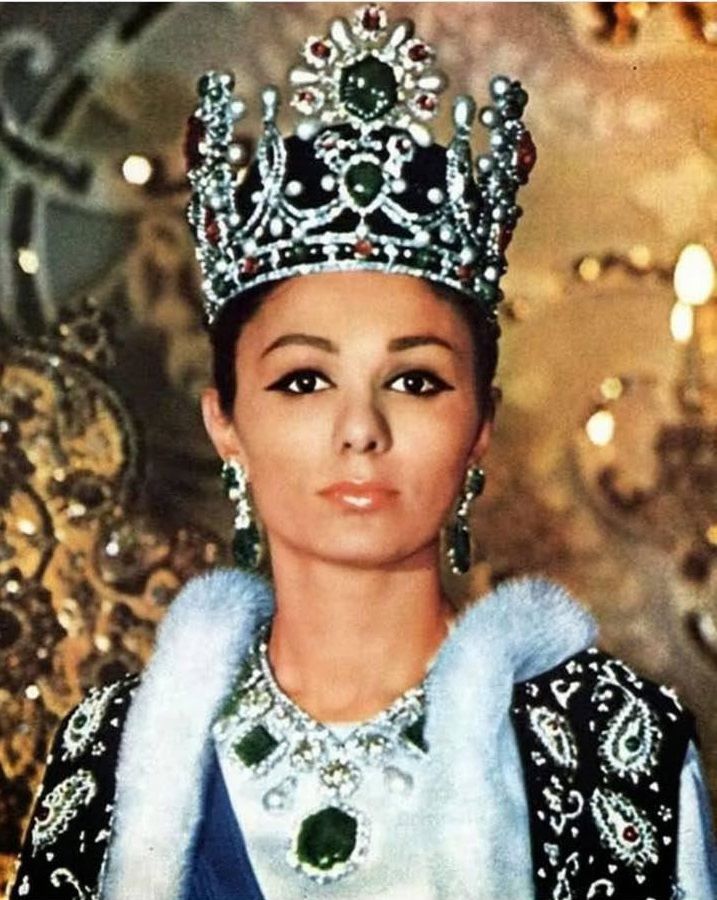|
Consort Crown
A consort crown is a crown worn by the consort of a monarch for their coronation or on state occasions. Unlike with reigning monarchs, who may inherit one or more crowns for use, consorts sometimes had crowns made uniquely for them and which were worn by no other subsequent consorts. All British queens consort crowned from 1831 to 1937, which included Adelaide of Saxe-Meiningen, Alexandra of Denmark, Mary of Teck and Elizabeth Bowes-Lyon, wore their own specially made consort crowns. Each queen went on to outlive her husband but, as a queen dowager, they retained the title, crown and other privileges of a queen for life. Previous English and British queens consort had used the State Crown of Mary of Modena, wife of King James II, until Adelaide of Saxe-Meiningen, the consort of King William IV, wore a new consort crown created for her. For the coronation of Charles III and Camilla in 2023, Camilla wore the Crown of Queen Mary. In Imperial Russia, there were no unique consort ... [...More Info...] [...Related Items...] OR: [Wikipedia] [Google] [Baidu] |
Crown (headgear)
A crown is a traditional form of head adornment, or hat, worn by monarchs as a symbol of their power and dignity. A crown is often, by extension, a symbol of the monarch's government or items endorsed by it. The word itself is used, particularly in Commonwealth countries, as an abstract name for the monarchy itself (and, by extension, the state of which said monarch is head) as distinct from the individual who inhabits it (that is, ''The Crown''). A specific type of crown (or coronet for lower ranks of peerage) is employed in heraldry under strict rules. Indeed, some monarchies never had a physical crown, just a heraldic representation, as in the constitutional kingdom of Belgium. Variations * Costume headgear imitating a monarch's crown is also called a crown hat. Such costume crowns may be worn by actors portraying a monarch, people at costume parties, or ritual "monarchs" such as the king of a Carnival krewe, or the person who found the trinket in a king cake. * The ... [...More Info...] [...Related Items...] OR: [Wikipedia] [Google] [Baidu] |
Imperial Crown Of Russia
The Imperial crown of Russia (), also known as the Great Imperial Crown of Russian Empire (), was used for the Coronation of the Russian monarch, coronation of the List of Russian rulers, monarchs of Russia from 1762 until the Russian Empire, Russian monarchy's abolition in 1917. The great imperial crown was first used in the coronation by Catherine the Great, and it was last worn at the Coronation of Nicholas II and Alexandra Feodorovna, coronation of Nicholas II of Russia, Nicholas II. It was displayed prominently next to Nicholas II on a cushion at the State Opening of the Russian Duma inside the Winter Palace in St. Petersburg in 1906. It survived the October Revolution, 1917 revolution and ensuing Russian Civil War, civil war and is currently on display in Moscow at the Kremlin Armoury's Diamond Fund, State Diamond Fund. Background By 1613, when Michael Romanov, the first Tsar of the Romanov Dynasty, was crowned, the Russian regalia included a pectoral cross, a golden chain ... [...More Info...] [...Related Items...] OR: [Wikipedia] [Google] [Baidu] |
Queen's Crown
The Queen's Crown (Polish: "korona królowych" or "korona Jadwigi kaliskiej") was a part of the Polish Crown Jewels until it was destroyed in 1809. It was mentioned for the first time in the inventory of the Wawel Royal Treasury in the 15th century. History The Polish Queen's coronation insignia were originally made for Jadwiga of Kalisz, wife of Władysław I the Elbow-high in 1320, intended for her coronation as a Queen consort of Poland. Since that time it served as the main insignium of the Polish Queens till the end of the 17th century. The crown was stolen from the Wawel Castle by the Prussian troops in 1794 and found its place in the collections of the Hohenzollerns in Berlin. After 1809 it was destroyed and melted down just as the majority of Polish regalia. The Queen's Crown consisted of eight segments each crowned with heraldic fleur-de-lis and interspersed with smaller pinnacles. It was made of pure gold in the form of the rims covered with the globe and a cross ... [...More Info...] [...Related Items...] OR: [Wikipedia] [Google] [Baidu] |
Kingdom Of Poland (other)
The Kingdom of Poland (; Latin: ''Regnum Poloniae'') was a monarchy in Central Europe during the medieval period from 1025 until 1385. Background The West Slavic tribe of Polans who lived in what is today the historic region of Greater Poland, gave rise to a state in the early 10th century, which would become the nascent predecessor of the Kingdom of Poland. Following the Christianization of Poland in 966, and the emergence of the Duchy of Poland during the rule of Mieszko I, his eldest son Bolesław I the Brave inherited his father's dukedom and subsequently was crowned as king. History Establishment In 1025, Bolesław I the Brave of the Piast dynasty was crowned as the first King of Poland at the cathedral in Gniezno and elevated the status of Poland from a duchy to a kingdom after receiving permission for his coronation from Pope John XIX. Following the death of Bolesław, his son Mieszko II Lambert inherited the crown and a vast territory after his father, wh ... [...More Info...] [...Related Items...] OR: [Wikipedia] [Google] [Baidu] |
Queen Of Norway's Crown
The crown for the Queen consort of Norway was made in 1830 for Désirée Clary's coronation. It did not take place, and was first used in 1860, for the coronation of Louise of the Netherlands. It was made in Stockholm and, though it is unknown by whom, probably by Marc Giron, the royal jeweller, some have speculated it may have been by Erik Lundberg, or, perhaps is a combination of both's work, and the design is probably based on the Swedish queen's crown. It is made of silver-gilt and gold, and is decorated with a number of multicoloured gems and pearls, including violet ( Amethysts), yellow ( Citrine and Topaz Topaz is a silicate mineral made of aluminium, aluminum and fluorine with the chemical formula aluminium, Alsilicon, Sioxygen, O(fluorine, F, hydroxide, OH). It is used as a gemstone in jewelry and other adornments. Common topaz in its natural ...) and green ( chrysoprase). It weighs approx 530g. See also * Regalia of Norway ReferencesOfficial Site - The cro ... [...More Info...] [...Related Items...] OR: [Wikipedia] [Google] [Baidu] |
Norway
Norway, officially the Kingdom of Norway, is a Nordic countries, Nordic country located on the Scandinavian Peninsula in Northern Europe. The remote Arctic island of Jan Mayen and the archipelago of Svalbard also form part of the Kingdom of Norway. Bouvet Island, located in the Subantarctic, is a Dependencies of Norway, dependency, and not a part of the Kingdom; Norway also Territorial claims in Antarctica, claims the Antarctic territories of Peter I Island and Queen Maud Land. Norway has a population of 5.6 million. Its capital and largest city is Oslo. The country has a total area of . The country shares a long eastern border with Sweden, and is bordered by Finland and Russia to the northeast. Norway has an extensive coastline facing the Skagerrak strait, the North Atlantic Ocean, and the Barents Sea. The unified kingdom of Norway was established in 872 as a merger of Petty kingdoms of Norway, petty kingdoms and has existed continuously for years. From 1537 to 1814, Norway ... [...More Info...] [...Related Items...] OR: [Wikipedia] [Google] [Baidu] |
Empress's Crown
The Empress's Crown or Shahbanu's Crown () is part of the coronation regalia used by the third '' Shahbanu'' (Empress) of Iran (Persia), Farah Pahlavi. The crown is part of the Iranian National Jewels, and is currently on display at the Treasury of National Jewels in Tehran. This crown is historically significant in the Iranian tradition. The two Sasanian empresses regnant, Boran and Azarmidokht, c. 630, were the last two that were crowned as shahbanu before Farah Pahlavi, consort of the last shah of Iran, Mohammad Reza Pahlavi, was crowned shahbanu in 1967, a first since the Muslim conquest of Persia in the 7th century. Background Following in the footsteps of policies initiated under the White Revolution that directed the further emancipation of Iranian women, Mohammad Reza Pahlavi determined to make a symbolic gesture by crowning his consort, Shahbanu Farah, during his own elaborate coronation ceremony in October 1967. The wives of Iranian monarchs had not been crowned si ... [...More Info...] [...Related Items...] OR: [Wikipedia] [Google] [Baidu] |
Pahlavi Dynasty
The Pahlavi dynasty () is an List of monarchs of Iran, Iranian royal dynasty that was the Pahlavi Iran, last to rule Iran before the country's monarchy was abolished by the Iranian Revolution in 1979. It was founded in 1925 by Reza Shah, Reza Shah Pahlavi, a non-aristocratic Iranian soldier of Mazanderani people, Mazanderani origin, who took on the name of the Pahlavi scripts of the Middle Persian, Middle Persian language from the Sasanian Empire of Muslim conquest of Persia, pre-Islamic Iran. The dynasty largely espoused this form of Iranian nationalism rooted in the pre-Islamic era (notably based on the Achaemenid Empire) during its time in power, especially under its last king Mohammad Reza Pahlavi. The dynasty replaced the Qajar dynasty in 1925 after the 1921 Persian coup d'état, 1921 coup d'état, beginning on 14 January 1921 when 42-year-old soldier Reza Shah, Reza Khan was promoted by British General Edmund Ironside, 1st Baron Ironside, Edmund Ironside to lead the Britis ... [...More Info...] [...Related Items...] OR: [Wikipedia] [Google] [Baidu] |
Crown Of The Queen Of Hungary
A crown is a traditional form of head adornment, or hat, worn by monarchs as a symbol of their power and dignity. A crown is often, by extension, a symbol of the monarch's government or items endorsed by it. The word itself is used, particularly in Commonwealth countries, as an abstract name for the monarchy itself (and, by extension, the state of which said monarch is head) as distinct from the individual who inhabits it (that is, ''The Crown''). A specific type of crown (or coronet for lower ranks of peerage) is employed in heraldry under strict rules. Indeed, some monarchies never had a physical crown, just a heraldic representation, as in the constitutional kingdom of Belgium. Variations * Costume headgear imitating a monarch's crown is also called a crown hat. Such costume crowns may be worn by actors portraying a monarch, people at costume parties, or ritual "monarchs" such as the king of a Carnival krewe, or the person who found the trinket in a king cake. * The nup ... [...More Info...] [...Related Items...] OR: [Wikipedia] [Google] [Baidu] |
Kingdom Of Hungary
The Kingdom of Hungary was a monarchy in Central Europe that existed for nearly a millennium, from 1000 to 1946 and was a key part of the Habsburg monarchy from 1526-1918. The Principality of Hungary emerged as a Christian kingdom upon the Coronation of the Hungarian monarch, coronation of the first king Stephen I of Hungary, Stephen I at Esztergom around the year 1000;Kristó Gyula – Barta János – Gergely Jenő: Magyarország története előidőktől 2000-ig (History of Hungary from the prehistory to 2000), Pannonica Kiadó, Budapest, 2002, , pp. 37, 113, 678 ("Magyarország a 12. század második felére jelentős európai tényezővé, középhatalommá vált."/"By the 12th century Hungary became an important European factor, became a middle power.", "A Nyugat részévé vált Magyarország.../Hungary became part of the West"), pp. 616–644 his family (the Árpád dynasty) led the monarchy for 300 years. By the 12th century, the kingdom became a European power. Du ... [...More Info...] [...Related Items...] OR: [Wikipedia] [Google] [Baidu] |
Crown Of Empress Eugénie
The Crown of Empress Eugénie is the consort crown that was made for Eugénie de Montijo, empress consort of Napoleon III, Emperor of the French. Although neither she or her husband had a coronation ceremony, a crown was specially created for her on the occasion of the 1855 Exposition Universelle (1855), Exposition Universelle in Paris. The gold crown is set with diamonds and emeralds in eagle and palmette motifs, and is topped by a ''monde''. During the same period, a crown was made for Napoleon III, which was known as the Crown of Napoleon III. After her husband was overthrown in 1870, following the Franco-Prussian War, they lived in exile at Chislehurst in England. He died in January 1873, and she died in July 1920. Most of the French Crown Jewels were sold by the French Third Republic, Third Republic in 1885, including the Crown of Napoleon III. [...More Info...] [...Related Items...] OR: [Wikipedia] [Google] [Baidu] |
Second French Empire
The Second French Empire, officially the French Empire, was the government of France from 1852 to 1870. It was established on 2 December 1852 by Louis-Napoléon Bonaparte, president of France under the French Second Republic, who proclaimed himself Emperor of the French as Napoleon III. The period was one of significant achievements in infrastructure and economy, while France reasserted itself as the dominant power in Europe. Historians in the 1930s and 1940s disparaged the Second Empire as a precursor of fascism, but by the late 20th century it was re-evaluated as an example of a modernizing regime. Historians have generally given the Second Empire negative evaluations on its foreign policy, and somewhat more positive assessments of domestic policies, especially after Napoleon III liberalised his rule after 1858. He promoted French business and exports. The greatest achievements included a railway network that facilitated commerce and tied the nation together with Paris a ... [...More Info...] [...Related Items...] OR: [Wikipedia] [Google] [Baidu] |







